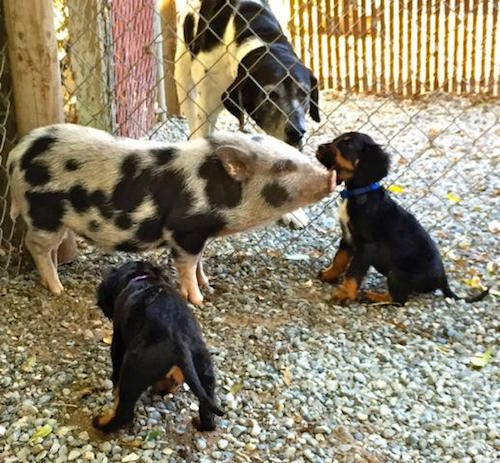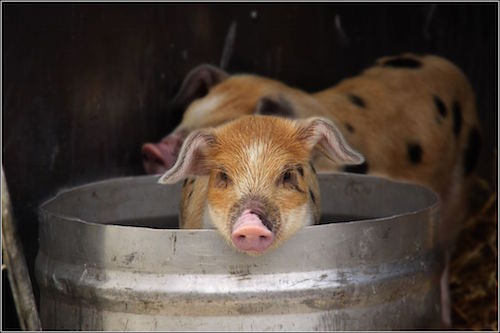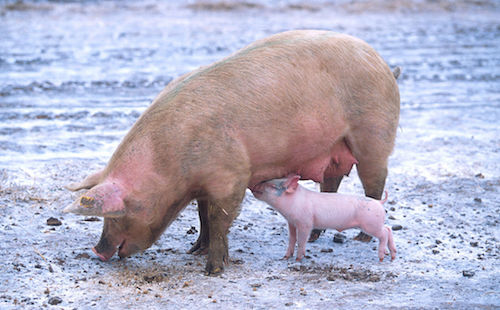152. The "Pig" Radical: 豕
The Japanese have two names for the "pig" radical 豕: ぶた and いのこ. The latter comes from the yomi of this non-Joyo autonomous kanji:
豕 (いのこ: hog)
Meanwhile,ぶた comes from the Joyo kun-yomi of the following kanji:
豚 (1670: pig, pork)
This is one of three Joyo kanji in which the seven-stroke 豕 radical is on duty. Here are the other two for which that's true:
象 (533: elephant; appearance)
豪 (1271: strong; great; Australia; luxurious)
We'll examine all three more closely, particularly to figure out how a pig turned into an elephant!
A Left-Side Radical?
Nelson indicates that when 豕 appears on the left side of a character, we should call the radical いのこへん. I found only one example, the non-Joyo 豬 (いのしし: hog, pig).
Differentiating 豕 from Another Radical
Although a pig and badger don't look much alike, the same is not true of the "pig" and "badger" radicals. Here's how they stack up:
豕 (radical 152: the "pig" radical)
豸(radical 153: the “badger” radical)
Differentiating 豕 from the Zodiacal Pig
As I write this, it's the Year of the Pig, also known as the Year of the Boar. But neither 豕 nor 豚 can represent that animal in a zodiacal context. Instead, we need yet another character:
亥 (い, representing いのしし: wild boar)
Note that this non-Joyo kanji does not feature the 豕 radical! What gives?!
The Etymology of 豚
Let's return to this kanji, which is central to our discussion:
豚 (1670: pig, pork)
The ancient Chinese originally used just 豕 to represent “pig." So it is that the on-duty radical on the right symbolizes "wild pig, boar," according to Henshall in his newer edition. The addition of 月 (meat, flesh) yielded 豚 as "plump wild piglet/boar (meat) to offer as a sacrifice."
Photo Credit: Eve Kushner
At a sheep farm in the Rokko Mountains near Kobe, this sign charmingly directs people to the 小豚園 (ミニブタエリア) section. I didn't know what was small, the pigs or the area, but this 小 modifies 豚, as 小豚 means "miniature pig."
Pigs Matter Here, Too
It's no surprise to find that the "pig" radical conveys a piggy meaning in 豚, but it's more surprising that that's true in 豪 (1271: strong; great; Australia; luxurious) and 劇 (848: theatrical performance; drama; severe). In the first case, 豕 is the on-duty radical, but this shape is merely a component in the second kanji. Let's look at each etymology to see what pigs are doing:
豪 (1271: strong; great; Australia; luxurious)
Kanjigen explains that 豪 consists of 豕 (porcupine) and a simplified version of the phonetic 高 (which means “being tall and standing out” here). Originally, 豪 referred to the porcupine’s long quills, which were tall and stood out, says that source.
Henshall says pretty much the same thing but more elaborately. In his new edition he tells us that the 豕 means “wild pig” or “boar” and that the remainder of the character is an abbreviated version of 高 (tall, high). Moreover, the phonetic at the top of 豪 contributes the associated sense of either “coarse animal hair” (yielding “porcupine” as the meaning of the whole character) or “long” (producing “boar or wild pig with long mane” as the meaning of 豪). A pig with a mane? That I’d like to see!
Henshall cites one scholar as saying that because the porcupine has a fierce nature, which is perceived as a positive trait, 豪 has acquired “outstanding” and “splendid” as extended definitions.
劇 (848: theatrical performance; drama; severe)
This character combines a "tiger" (虍) with a "pig" (豕) and a "sword" (刂)! How is that going to work out? Who will prevail?! As Henshall explains in his earlier book, some scholars see 劇 as depicting an "attack with a sword in the manner of a tiger attacking a pig." He calls "intense" an extended meaning and says that "drama" could be a borrowed definition or could stem from the idea of "exciting and intense."
His later edition offers a completely different interpretation in which the left side of 劇 represents a "mythical beast with a tiger's head." That phonetic might convey "extremely violent" and "extreme."
So far we've seen a pig (or hog or boar or wild boar), elephant, porcupine, and tiger! We have also encountered plumage belonging to no animal in particular!
Pigs on the Move
In the next character, the pig matters again, even though it's a mere component:
遂 (1458: to accomplish; finally)
The left-hand radical 辶 means "movement," and all the rest represents "(group of) pigs moving," says Henshall. That latter shape refers to pigs' moving out of an enclosure, often connoting "pushing" and "jostling." He comments that "pigs moving in a group" came to refer to "group movement," especially in the sense of "attaining a goal through the brute force of the group." This broadened to "attain," with "finally" being an associated meaning.
The pigs are just as pushy in the new edition but the interpretation has become muddier. The whole character might represent "(group of) wild boars push others aside and move forward," says Henshall there.
Pigs in the House?
If there's one thing people associate with pigs, it's filth. In both Japanese and English, the best way to criticize a room for being unclean is to call it a pigsty. It's therefore rather shocking to spot a pig inside the very common kanji for house!
家 (83: house; family; professional; someone performing an action; territory)
The newer Henshall edition says that the 豕 in 家 might actually be a dog! But don't imagine a cozy domestic scene with a dog by the fireplace; one scholar who interprets that component as "dog" notes that dog sacrifice was common in ancient China. If the shape does represent "pig," it could be because humans and pigs lived in similar structures back then, says Henshall. Alternatively, the 豕 might phonetically express "leisure" or "relax." The 宀 crowning the character means "building," so 家 is a "building for relaxing." Essentially, no one knows what's going on here!

Photo Credit: Ellie Fidler
Not Pigs but Elephants
Now we shift from pigs and dogs to elephants:
象 (533: elephant; appearance)
This character is a pictograph of an "elephant," says Henshall. In his second edition he mentions that the latter definition became associated with 象 because the ancient Chinese words for "elephant" and "image" were homophonous.
Our radical is on duty here, even though it's somewhat hard to spot, crushed as it is by the weight of an elephant! Anyway, 象 just happens to look like 豕 and was categorized under radical 152 purely for convenience. There's nothing piglike about an elephant!
Two "Pig" Radicals in a Row
This sign contains two instances of our "pig" radical:
Photo Credit:
Eve Kushner
What's more, they're in consecutive kanji! The latter is 劇 (848: theatrical performance). Above that we have 塚 (1607: mound, hillock). More on that kanji in a moment.
This sign is for the Takarazuka Revue, an extremely popular type of Japanese musical theater in which women play both male and female roles. The group formed in 1914 in Takarazuka, a city about 20 kilometers northwest of Osaka. The group now has a second home at the Tokyo Takarazuka Theater, across the street from the Imperial Hotel in Tokyo.
The characters in the sign break down this way:
東京 (とうきょう: Tokyo)
宝塚 (たからづか: Takarazuka)
劇場 (げきじょう: theater, playhouse)
One famous person with 塚 in his name was 手塚治虫 (Osamu Tezuka), the Walt Disney of Japan. As it turns out, he grew up in Takarazuka and often saw the Takarazuka Revue. Their performances influenced several of his manga creations. His success then inspired them to base some performances on his work. There’s now a Tezuka museum in the city of Takarazuka. So many 塚s at once!
The Presumed Pig
Let's investigate this swinish aspects of this character:
塚 (1607: mound, hillock)
Henshall's newer edition says that the 豕 might contribute the meaning "fat castrated pig" (!) and might phonetically express "big," though this analysis doesn't say how that factors into "mound." Another interpretation has a canine take on 豕, though in that case the shape represents not just "dog" but "dog sacrifice." Accounting for 冖 (cover) and 土 (earth), as well, you have "cover dog sacrifice with earth," which is to say "mound, grave."
The new edition contains another explanation, one involving 豕 as a "hobbled pig."
Summing things up, Henshall leans toward interpreting the 豕 in 塚 as "pig," at least in a mnemonic. In discussing this, he refers to the "presumed pig"!


